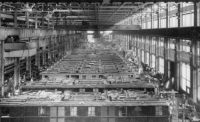The world was a much different place when William Boeing started to build aeroplanes in a small boathouse along the shore of Seattle’s Lake Union in 1916. Flying machines were still a novelty. Most aviation records, such as altitude, distance and speed, were held by European aircraft manufacturers and pilots.
The most advanced aircraft were made in France and Germany. The fledgling American industry was led by Curtiss Aeroplane and Motor Co. and Wright-Martin.
Most planes were made out of wood and covered with fabric. However, a German engineer named Hugo Junkers had just built the world’s first practical all-metal plane.
The fuselage of the Junkers J 1 used welded strip-steel angle stock, along with some steel tubing, to form its main internal structure. Junkers covered his plane with 17-inch wide sheet metal panels wrapped around the fuselage.
World War I was raging in Europe and was about to have a profound impact on the aviation industry. It was the last major war fought with horses, and the first war fought with airplanes and airships. Other new military technology used on the battlefield included machine guns and tanks.
One-on-one aerial duels and dogfights between France’s Charles Nungesser, Germany’s Manfred von Richthofen (the “Red Baron”) and other flying aces, romanticized pilots and helped spur interest in aviation.
Aircraft found their first practical use during World War I. Although the airplane’s impact on the war’s outcome was limited, it played a key role in reconnaissance and artillery spotting. Aircraft designs also matured as more powerful engines, accurate controls and sturdier airframes were developed.
Two of the bloodiest battles in history were fought along the Western Front in France during 1916. A nine-month-long skirmish at Verdun resulted in more than 750,000 casualties. But, that paled in comparison to a four-month battle at the Somme River that produced more than 1 million casualties.
The big topic of debate on the home front was whether or not the United States should get involved with the “Great War.” One of the biggest pacifists was Henry Ford (the year before, he sponsored a peace ship that sailed to Europe).
Woodrow Wilson became the first Democratic president since Andrew Jackson to be elected to two consecutive terms of office when he defeated Supreme Court Justice Charles Evans Hughes. Wilson campaigned on a peace platform and tried to keep the United States from participating in World War I. (The U.S. eventually entered the conflict in April 1917.)
The war dramatically changed the political and geographic landscape of Europe and marked the end of the British Empire, the Hapsburg Empire and the Ottoman Empire.
Here’s a brief look at what else was going on in the world of business, consumer products, science, sports and entertainment when Boeing was established.
- Congress passes the Organic Act, which establishes the National Park Service.
- In Dublin, Irish nationalists rebel against British rule by taking over the general post office and making a declaration of Irish independence. The Easter Rising eventually leads to the establishment of the Irish Free State in 1922.
- Henry Ford offers equal pay—now $5 per day—to his female employees.
- Keds sneakers are introduced by the U.S. Rubber Co.
- Albert Einstein publishes his general theory of relativity.
- British engineers invent underwater sonar. In response to the sinking of the ocean liner, RMS “Lusitania,” by a German U-boat the year before, they develop a submarine detection system consisting of a line of hydrophones towed behind a ship.
- The Owen-Keating Law prohibits the interstate trade of goods made in factories using child labor.
- Artist Claude Monet begins working on a series of impressionist paintings based on the water lilies in the pond of his garden at Giverny, France.
- American troops led by General John “Black Jack” Pershing pursue Mexican revolutionary Francisco “Pancho” Villa.
- The Olympic Games in Berlin are cancelled due to World War I.
- On Wall Street, companies listed on the Dow Jones Industrial Average include the American Locomotive Co., Baldwin Locomotive Works, Central Leather Co., Studebaker Corp. and Western Union Telegraph Co.
- D.W. Griffith’s motion picture “Intolerance” debuts.
- Cross-licensing agreements, which allow for sharing the benefits of patents, take effect throughout the auto industry.
- Jeannette Rankin becomes the first woman to serve in Congress.
- Tuning devices for radios are introduced.
- The Federal Road Aid Act is passed by Congress. It provides funds for the improvement of any rural road over which the U.S. mail is carried, paving the way for a national system of highways.
- Fortune cookies are invented in Los Angeles by the Hong Kong Noodle Co.
- Cadillac becomes a division of General Motors.
- Carl Sandburg publishes his famous poem “Chicago.” It’s his ode to the “city of big shoulders.”
- Lincoln Logs are invented by John Lloyd Wright, the son of architect Frank Lloyd Wright.
- Automotive design trends include slanted windshields and dual-cowl bodies.
- Popular entertainers include Enrico Caruso, Al Jolson and John McCormack.
- The bobby pin is invented.
- An unknown illustrator named Norman Rockwell paints his first cover for the Saturday Evening Post.
- Charlie Chaplin earns an unprecedented $10,000 a week for making silent movies.
- Navy Pier opens in Chicago.
- The Boston Red Sox defeat the Brooklyn Dodgers to capture the World Series.
- The Professional Golfers Association (PGA) is established.
- Dario Resta wins the Indianapolis 500 driving a Peugeot. His average speed is 84 mph. However, the race only covers 300 miles in an attempt by organizers to make it more appealing to fans.
- The Montreal Canadiens defeat the Portland Rosebuds to win the Stanley Cup.
- The Chicago Cubs play their first game at Wrigley Field (at the time, the stadium is called Weeghman Park).







